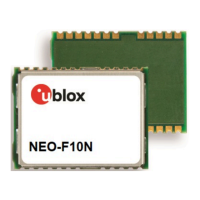NEO-F10N-Integration manual
Interface Configuration groups
UART CFG-UART1-*, CFG-UART1INPROT-*, CFG-UART1OUTPROT-*
Table 6: Interface configuration
2.1.6 Message output configuration
The receiver supports two protocols for output messages: industry-standard NMEA and u-blox UBX.
Any message type can be enabled or disabled individually and the output rate is configurable.
The message output rate is related to the frequency of an event. For example, the output message
UBX-NAV-PVT (position, velocity, and time solution) is related to the navigation event, which
generates a navigation epoch. In this case, the rate for each navigation epoch is defined by the
configuration keys CFG-RATE-MEAS and CFG-RATE-NAV. For example, a value of 1000 ms in CFG-
RATE-MEAS indicates that a measurement is done every second. If CFG-RATE-NAV is set to one (1),
the solution is calculated for every measurement. This means that a navigation epoch is calculated
every 1000 ms. If the rate is set to two (2), only the second measurement is used and the navigation
epoch is calculated every two seconds. The same result is obtained if CFG-RATE-MEAS is set to
2000 ms, and CFG-RATE-NAV is set to one (1). Every 2000 ms a measurement is done, and in
every measurement, a navigation epoch is calculated. However, this second option demands fewer
resources and is the correct procedure when the navigation rate is changed. Setting a navigation
rate value higher than one (1) is only needed when it is required that the raw measurement data is
output at a higher rate than the navigation data.
The output rate for each message is defined in the CFG-MSGOUT-* configuration group. If
the output rate of the message is set to one (1) on the UART interface, CFG-MSGOUT-
UBX_NAV_PVT_UART1 = 1, the message is output for every navigation epoch. If the rate is set to two
(2), the message is output for every other navigation epoch. If the rate is zero (0), then corresponding
message is not output. As seen in this example, the rates of the output messages are individually
configurable per communication interface.
Some messages, such as UBX-MON-VER, are non-periodic and are only output as an answer to a
poll request.
The UBX-INF-* and NMEA-Standard-TXT information messages are non-periodic output messages
that do not have a message rate configuration. Instead they can be enabled for each communication
interface via the CFG-INFMSG-* configuration group.
All message output is additionally subject to the protocol configuration of the communication
interfaces. Messages of a given protocol are not output unless the protocol is enabled for output
on the interface. See Communication interface configuration for details.
2.2 Navigation configuration
This section presents various configuration options related to the navigation engine. These options
can be configured through CFG-NAVSPG-* configuration keys.
2.2.1 Dynamic platform
The dynamic platform model can be configured through the CFG-NAVSPG-DYNMODEL
configuration item. For the supported dynamic platform models and their details, see Table 7 and
Table 8.
Platform Description
Portable Applications with low acceleration, e.g. portable devices. Suitable for most situations.
UBXDOC-963802114-12193 - R02
2 Receiver configuration Page 11 of 42
C1-Public

